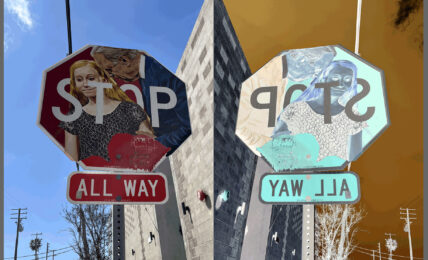Eric Souther is a new media artist who draws from an assortment of disciplines, including anthropology, linguistics, ritual, critical theory, and new materialism. He is currently an Assistant Professor of Expanded Media in the Division of Expanded Media at NYSCC at Alfred University. His video piece Exponential Growth (2020) creates an anxious series of video glitches by “throttling the networks bitrate and creating a feedback loop by taking the in back to the out.”
:::
DigA: Looking over the arc of your portfolio, you seem to move from prints to video art. What inspired this transition to works like the Search Engine Vision series?
ES: At the core of my practice is and has always been video art. I started creating prints in graduate school during my Electronic Integrated Arts (EIA) M.F.A at the New York State College of Ceramics School of Art and Design at Alfred University. The EIA program encourages and celebrates integrative approaches between Print Media and Video Art. An approach I still practice today.
DigA: Exponential Growth is a piece about the human race, capitalism, and climate change. —exploring specifically how the United States approach is lacking. How do you hope Exponential Growth will influence viewers to rethink their livelihoods and the system we are living in today?
ES: Exponential Growth is a visualization and document of the non-human phenomena of COVID-19, the glitch in our capitalistic society. As an artwork existing in this society, I am aware of its reach and impact for viewers outside an academic and progressive bubble is limited by design. Bubbles are reinforced by social media to keep a hyper-normalization for consistent capitalistic futures. COVID-19 is the pedagogical force that has brought attention to our current systems’ shortcomings and failure. I hope these failures will ask all of us to rethink our livelihoods and how we participate in meaning and value in our society. Exponential Growth is simply an artifact, a marker of this time.
DigA: With the political instability in the US, how do you hope the Search Engine Vision Series responds to 2020 and beyond, with the ongoing global pandemic as well as economic and political uncertainty?
ES: The Search Engine Vision (S.E.V.) Series digs into the cultural strata of images and embedded in media and how we find and tag meaning online. Our media has never been so polarized and divisive. The S.E.V. series of works for me have always celebrated the expansiveness and multiplicities of meaning; it evades binary ways of thinking. I plan to expand S.E.V. The White House to include 2019 and 2020, thereby giving a twenty-year arc to our notions and associated meanings attached to The White House as a symbol of democracy.
I have also been working on a large-scale map of the United States that contains 500 videos for each State, for each year, from 2005 (start of YouTube) to 2020. Videos are included by downloading the search results of individual states’ names. The work in progress is in conversation with Nam June Paik’s Electronic Superhighway, 1995, which gives us a popular film and television picture of our American landscape. S.E.V. America will be led by the search results for each state. I expect to see a wider range of meaning and scales of perspective by institutions and individuals. I am interested in seeing both the media makeup and shifts in our country’s values changes over the past 15 years.
DigA: In your series Dissecting Muybridge you recontextualize Eadweard Muybridge’s late nineteenth century chronophotography, to both critique and analyze the language of film through the immediacy of video. What inspired you to explore Muybridge’s late nineteenth century chronophotography?
ES: I am interested in Muybridge as an artist and toolmaker. The tools and systems he built allowed for new ways of seeing time for the first time. These explorations in system building and photographing lead to his development of chronophotography and then the zoopraxiscope. Essential steps in creating film and the moving image. Just as the printing press, the moving image has profoundly changed how we know, relate, and exist in the world today. The series investigates the history and evolution of the moving image and the shifting metaphors across the mediums of film, analog video, and digital images.
DigA: Can you talk a bit about your current projects?
ES: My current projects investigate the material-discursive agencies of human and non-humans from a new materialist approach to thinking and making. I am significantly influenced by Karen Barad’s Agential Realism outlined in her book Meeting the Universe Halfway: The Quantum Physics and the Entanglement of Matter and Meaning. I also situate my work in relation to the history of video and its sub-genera image/signal processing, emerging in the 1970s. A history of artists and toolmakers making their own video instruments to augment the video signal. Which happened at places like the Experimental Television Center in Owego, NY, and continues to occur with organizations like Signal Culture. Image processing brings attention to the video signal’s malleability as a material that can be sculpted in real-time. I create my own instruments that become the non-human agencies that I enter a dialog with. A good dialog happens when there are states of indeterminacy and emergence. I have recently been interested in seeing how other materials like ceramics, glaze, lasers, and XY plotter drawing function as material image processing. For me, this is a new materialist approach to image/signal/material processing.
Check out Eric Souther’s Exponential Growth.
:::
 Eric Souther is a new media artist who draws from an assortment of disciplines, including anthropology, linguistics, ritual, critical theory, and new materialism. He develops software instruments and codes that investigate technological & cultural ecologies. His work has been featured nationally and internationally at venues such as the Museum of Art and Design, NYC, Everson Museum of Art, Syracuse, NY, and the Museum of Art, Zhangzhou, China. His work has screened in The Athens Digital Arts Festival, Athens, Greece, Istanbul International Experimental Film Festival, Beyoglu, Instanbul, Cronosfera Festival, Alessandria, Italy, the Galerija 12 New Media Hub, Belgrade, Serbia, and the Simultan Festival, Timisoara, Romania. He received his B.F.A in New Media from the Kansas City Art Institute in 2009 and his M.F.A. in Electronic Integrated Arts from the New York State School of Ceramics at Alfred University in 2011. He is currently an Assistant Professor of Expanded Media in the Division of Expanded Media at NYSCC at Alfred University.
Eric Souther is a new media artist who draws from an assortment of disciplines, including anthropology, linguistics, ritual, critical theory, and new materialism. He develops software instruments and codes that investigate technological & cultural ecologies. His work has been featured nationally and internationally at venues such as the Museum of Art and Design, NYC, Everson Museum of Art, Syracuse, NY, and the Museum of Art, Zhangzhou, China. His work has screened in The Athens Digital Arts Festival, Athens, Greece, Istanbul International Experimental Film Festival, Beyoglu, Instanbul, Cronosfera Festival, Alessandria, Italy, the Galerija 12 New Media Hub, Belgrade, Serbia, and the Simultan Festival, Timisoara, Romania. He received his B.F.A in New Media from the Kansas City Art Institute in 2009 and his M.F.A. in Electronic Integrated Arts from the New York State School of Ceramics at Alfred University in 2011. He is currently an Assistant Professor of Expanded Media in the Division of Expanded Media at NYSCC at Alfred University.



